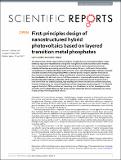| dc.contributor.author | Lentz, Levi Carl | |
| dc.contributor.author | Kolpak, Alexie M. | |
| dc.date.accessioned | 2017-06-22T15:22:00Z | |
| dc.date.available | 2017-06-22T15:22:00Z | |
| dc.date.issued | 2017-04 | |
| dc.date.submitted | 2017-02 | |
| dc.identifier.issn | 2045-2322 | |
| dc.identifier.uri | http://hdl.handle.net/1721.1/110168 | |
| dc.description.abstract | The performance of bulk organic and hybrid organic-inorganic heterojunction photovoltaics is often limited by high carrier recombination arising from strongly bound excitons and low carrier mobility. Structuring materials to minimize the length scales required for exciton separation and carrier collection is therefore a promising approach for improving efficiency. In this work, first-principles computations are employed to design and characterize a new class of photovoltaic materials composed of layered transition metal phosphates (TMPs) covalently bound to organic absorber molecules to form nanostructured superlattices. Using a combination of transition metal substitution and organic functionalization, the electronic structure of these materials is systematically tuned to design a new hybrid photovoltaic material predicted to exhibit very low recombination due to the presence of a local electric field and spatially isolated, high mobility, two-dimensional electron and hole conducting channels. Furthermore, this material is predicted to have a large open-circuit voltage of 1.7 V. This work suggests that hybrid TMPs constitute an interesting class of materials for further investigation in the search for achieving high efficiency, high power, and low cost photo Zirconium phosphate was chosen, in part, due to previous experiment voltaics. | en_US |
| dc.description.sponsorship | Solid-State Solar-Thermal Energy Conversion Center (DE-SC0001299) | en_US |
| dc.description.sponsorship | Solid-State Solar-Thermal Energy Conversion Center (DE-FG02-09ER46577) | en_US |
| dc.language.iso | en_US | |
| dc.publisher | Nature Publishing Group | en_US |
| dc.relation.isversionof | http://dx.doi.org/10.1038/s41598-017-01296-0 | en_US |
| dc.rights | Creative Commons Attribution 4.0 International License | en_US |
| dc.rights.uri | http://creativecommons.org/licenses/by/4.0/ | en_US |
| dc.source | Nature | en_US |
| dc.title | First-principles design of nanostructured hybrid photovoltaics based on layered transition metal phosphates | en_US |
| dc.type | Article | en_US |
| dc.identifier.citation | Lentz, Levi C. and Kolpak, Alexie M. “First-Principles Design of Nanostructured Hybrid Photovoltaics Based on Layered Transition Metal Phosphates.” Scientific Reports 7, no. 1 (April 2017): 1248 © 2017 The Author(s) | en_US |
| dc.contributor.department | Massachusetts Institute of Technology. Department of Mechanical Engineering | en_US |
| dc.contributor.mitauthor | Lentz, Levi Carl | |
| dc.contributor.mitauthor | Kolpak, Alexie M. | |
| dc.relation.journal | Scientific Reports | en_US |
| dc.eprint.version | Final published version | en_US |
| dc.type.uri | http://purl.org/eprint/type/JournalArticle | en_US |
| eprint.status | http://purl.org/eprint/status/PeerReviewed | en_US |
| dspace.orderedauthors | Lentz, Levi C.; Kolpak, Alexie M. | en_US |
| dspace.embargo.terms | N | en_US |
| dc.identifier.orcid | https://orcid.org/0000-0002-1353-9326 | |
| dc.identifier.orcid | https://orcid.org/0000-0002-4347-0139 | |
| mit.license | PUBLISHER_CC | en_US |
